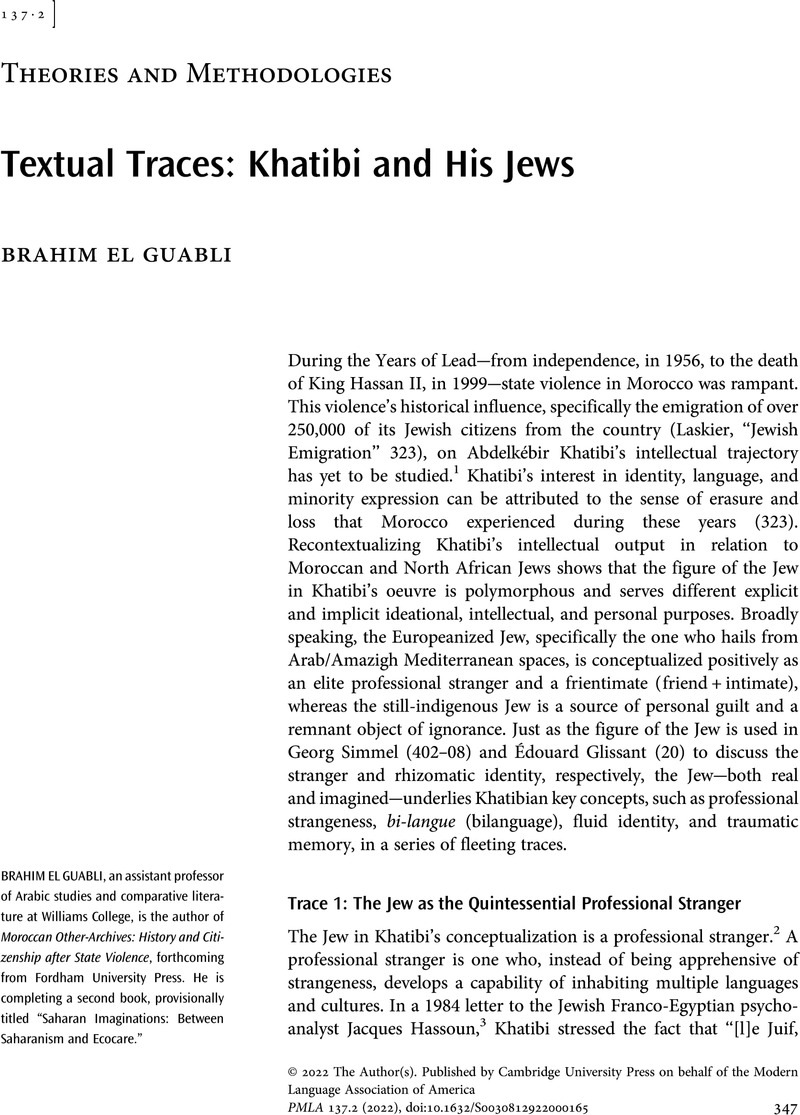No CrossRef data available.
Article contents
Textual Traces: Khatibi and His Jews
Published online by Cambridge University Press: 25 May 2022
Abstract
An abstract is not available for this content so a preview has been provided. Please use the Get access link above for information on how to access this content.

- Type
- Theories and Methodologies
- Information
- Copyright
- Copyright © 2022 The Author(s). Published by Cambridge University Press on behalf of the Modern Language Association of America
References
Works Cited
Benichou Gottreich, Emily. The Mellah of Marrakesh: Jewish and Muslim Space in Morocco's Red City. Indiana UP, 2007.Google Scholar
Blatterer, Harry. “Intimacy as Freedom: Friendship, Gender and Everyday Life.” Thesis Eleven, vol. 132, no. 1, 2016, pp. 62–76.CrossRefGoogle Scholar
El Guabli, Brahim. “Breaking Ranks with National Unanimity: Novelistic and Cinematic Returns of Jewish-Muslim Intimacy in Morocco.” Intellectuals, Cultural Production, and the State in the Middle East and North Africa, edited by Firat, Alexa and Taleghani, R. Shareah, Syracuse UP, 2020, pp. 159–88.Google Scholar
El Guabli, Brahim. “Khatibi and His Jews: Constructions of the Figure of the Jew in Abdelkébir Khatibi's Writings.” UCLA Center for Near Eastern Studies, Regents of the University of California, 2022, international.ucla.edu/cnes/article/241749.Google Scholar
El Guabli, Brahim. Moroccan Other-Archives: Citizenship and History after State Violence. Fordham UP, 2022.Google Scholar
Glissant, Édouard. Poetics of Relation. Translated by Wing, Betsy, Michigan UP, 1997.CrossRefGoogle Scholar
Goldberg, Harvey E. “The Mimuna and the Minority Status of Moroccan Jews.” Ethnology, vol. 17, no. 1, 1978, pp. 75–87.CrossRefGoogle Scholar
“The Hadith of the Prophet Muhammad (صلى اللَّه عليه و سلم ) at Your Fingertips.” Sunna.com, sunna.com.Google Scholar
Hammoudi, Abdellah. “Le don entre juifs et musulmans: Ou comment concilier les identités opposées.” CARGO: Revue internationale d'anthropologie culturelle et sociale, 2016, pp. 91–106.Google Scholar
Ifrah, Albert. Juifs du Maroc: Actes du colloque international sur la communauté juive marocaine: Vie culturelle, histoire sociale et évolution (Paris, 18–21 décembre 1978). Pensée Sauvage, 1980.Google Scholar
Jamieson, Lynn. “Boundaries of Intimacy.” Families in Society: Boundaries and Relationships, edited by McKie, Linda and Cunningham-Burley, Sarah, Policy Press, 2005, pp. 189–206.CrossRefGoogle Scholar
Khatibi, Abdelkébir. Figures de l’étranger dans la littérature française. Denoël, 1987.Google Scholar
Laskier, Michael M. The Alliance Israélite Universelle and the Jewish Communities of Morocco, 1862–1962. State U of New York P, 1984.Google Scholar
Laskier, Michael M. “Jewish Emigration from Morocco to Israel: Government Policies and the Position of International Jewish Organizations, 1949–56.” Middle Eastern Studies, vol. 25, no. 3, 2006, pp. 323–62.CrossRefGoogle Scholar
Simmel, Georg. The Sociology of Georg Simmel. Translated by Wolff, Kurt, Free Press, 1950.Google Scholar


